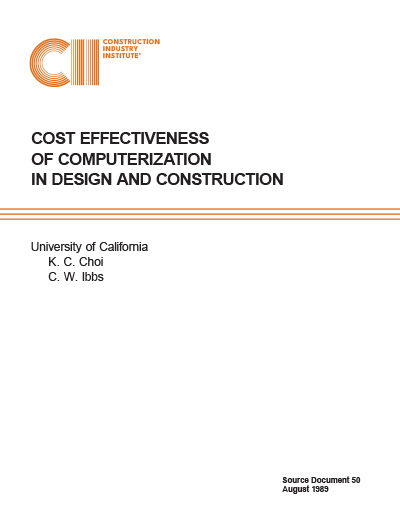
CAD/CAE in the Construction Industry
Computer aided design (CAD) and computer aided engineering (CAE) are important tools for today’s construction industry. They are affecting the way our business is being done.
The construction industry has accepted the use of computers in a variety of ways. Management is concerned that the use of computers is less than cost effective. Largely because of this concern, the Design Task Force sponsored a study to evaluate the usage of CAD and CAE in the member companies of CII.
The study led the Design Task Force to believe that:
- CAD/CAE technology will overwhelmingly be the most important contributor to improvement among CII companies in project quality and efficiency in the foreseeable future.
- The industry is on the verge of an order-of-magnitude improvement in efficiency and benefits resulting from the utilization of computerization.
The primary objective of the task force study was to collect information and to share lessons learned about the computerization efforts of CII member companies.
This report will assist the industry in the task of computerization and point out some key elements of success. Opinions regarding computerization trends for the next five years have been identified and are contained in this report.
Even though CII companies have experienced average home office hour reduction, of 26 percent through computerization, CAD/CAE (from the viewpoint of cost by most respondents) has been break-even at best in engineering and home office efforts over the past five years.
Vendors of hardware and software have made this effort more difficult for management by inflating the projected efficiencies of the systems and downplaying the difficulties necessary to use them.
Participants in a September 1988 workshop concluded that benefits are measurable in terms of better designs with improved productivity and schedules. Strong evidence shows that once menus, databases and libraries are created, costs as well as hours can be reduced.
Downstream benefits have been identified and are believed to offer the greatest potential for future realization, but have not yet been broadly realized or quantified by CII member companies.
Obstacles to rapid progress in this process consist of the following:
- Management’s lack of understanding of the technology and its potential.
- The difficulty of companies to train and integrate people into a computerized environment.
- A lack of standards among vendors, engineer-contractors and owners.
- The lack of system software and hardware compatibility from system to system.
- The time required for people to adapt to a whole new way of processing information.
The participants in this study predict the future to include the networking of computers in the offices of the engineer, the owner and the construction field office. One source of information will exist, and it will reside in the computer and be accessible by project participants on the basis of need. Different vendors’ hardware and software systems will communicate with each other. Object-oriented, database-driven CAD/CAE systems are expected to be in general use. Expert systems, artificial intelligence concepts and dynamic plant walk-through programs are expected to be common tools. Simulation of the conceptual design of projects will be among the engineer-constructor's capabilities.
A computer will be as common as today’s hand-held calculator and become the link between a variety of communications and reproduction.
Industries will develop unique databases. Companies will draw information from their own company databases and industry databases to create project databases for construction and other business requirements of owners.
Schedules will be shorter, budgets will be more accurately refined and project quality will improve.
Hardware and software already exist to do the things visualized as the future. A few companies already are performing tasks that are predicted for the future. Management's ability to drive this technology to a cost-effective conclusion on projects and the creation of an educated work force to use it are the obstacles to its realization.
Computerization technology and implementation are moving at a pace that is making today’s tools and methodology obsolete at an alarming rate. CAD/CAE usage in the next five years is viewed as an exciting and promising time for the construction industry.
The benefits that increased the overall cost effectiveness of computerization for the engineering companies included the following: (RS8-3, p. 12)
- Streamlining and integrating the engineering process. The quality of the design was improved by maintaining consistency, accuracy, and economy of design.
- Reduced engineering costs due to easy revisions and easy reuse of engineering information and documents from prior projects.
- Intelligent models that generate accurate, reliable quantities of materials and components could be created.
- Improved efficiency and shortened engineering schedules by responsive information management and the utilization of central databases.
- Elimination of the need for plastic models (these were widely used until the advent of computer models).
The potential downstream benefits to the customer of computerization were:
- Better materials management and control which reduced the incidences of shortages and surpluses.
- Improved constructability through easier incorporation of construction knowledge fed back to the design houses.
- Improved construction project schedules.
- Less field rework and fewer change orders due to more accurate drawings.
- Improved plant operability and plant safety.
- An electronic database that can be valuable for continued facility management.
- Lower life-cycle plant costs by reducing operating and maintenance costs, including energy costs, through additional engineering capabilities.
- Better communications between owner, engineer, and contractor with better design documents.
The studies pointed out that the industry faced many challenges when implementing computerization, and it is noteworthy that many of these same issues face companies today, such as: (RS8-3, p. 10)
- The costs associated with the acquisition and maintenance of systems.
- The cost of training and system support.
- The time and costs involved with preparation of menus libraries, databases, and utility programs.
- The tendency of software vendors to make the effort of evaluating the cost effectiveness of new design tools more difficult for company management by inflating the projected efficiencies of the systems and downplaying the difficulties necessary to use them, especially the upfront configuration and training.
- The lack of understanding of design technology by the company management that is making the purchase decisions.
- Incompatibility between design tools that made sharing of information between companies more difficult, reducing the value of that information.
- Resistance to changes in design technology by company personnel. Users tend to be satisfied with what they are most familiar and reluctant to invest the time to master new software and hardware, even when that technology is faster, more user friendly and more productive.
The study analyzed the trends in computer skills, including: (RS8-3, p. 9)
- Training – Project and corporate functional managers will require training to understand the technology and importance of design software, and the investment in time and resources required for implementation.
- The education of experienced, qualified technical personnel in the use of the computer is the cost effective way to develop trained personnel. The use of personnel who are knowledgeable in computers to solve engineering problems for which they are not technically experienced does not work well.
- Training Documentation – The value of training documentation and support for the users of software tools in engineering cannot be underestimated.
Is an example of a framework for evaluating design effectivenss as suggested by a workshop group.


